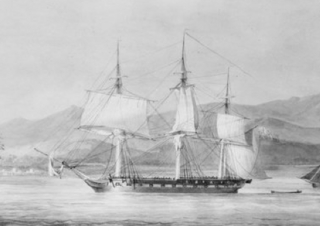
Var was a corvette of the French Navy, launched in 1806 as the name-ship of her class of flutes. She served as a storeship until the British captured her in 1809. She became the transport HMS Chichester, and was wrecked in 1811.

HMS Foxhound was an 18-gun Cruizer-class brig-sloop built by King at Dover and launched in 1806. She participated in the battle of the Basque Roads in early 1809 and foundered later that year.

HMS Ferret was a Royal Navy Cruizer-class brig-sloop built by Benjamin Tanner at Dartmouth and launched in 1806, 19 months late. She served on the Jamaica, Halifax, and Leith stations during which time she took three privateers as prizes before she was wrecked in 1813.
HMS Firm was a 12-gun Archer-class gun-brig of the Royal Navy, launched on 2 July 1804. She served in the Channel, where she engaged in one action that would eventually result in her crew qualifying for the Naval General Service Medal. She grounded in 1811 and her crew had to destroy her before abandoning her.
HMS Harrier was a Cruizer-class brig-sloop launched in 1804. She took part in several notable actions before she was lost in March 1809, presumed foundered.
HMS Fleur de la Mer was the French privateer Gipsey, captured in 1806. The British Royal Navy bought her in 1807 and she served until she foundered in 1810.
HMS Claudia was an Adonis-class schooner of the Royal Navy during the Napoleonic War. She was built at Bermuda using Bermudan cedar and completed in 1806. She was commissioned under Lieutenant Anthony Bliss William Lord in March 1806.

HMS Delight was a British Royal Navy 16-gun brig-sloop of the Seagull class launched in June 1806, six months late. She grounded off Reggio Calabria in January 1808 and was burnt to prevent her being salvaged.

HMS Julia was a British Royal Navy 16-gun brig-sloop of the Seagull class launched in February 1806. After a fairly uneventful decade-long career she was wrecked at Tristan da Cunha in 1817 with heavy loss of life.

HMS Grasshopper was a Cruizer-class brig-sloop of the Royal Navy. She was launched in 1806, captured several vessels, and took part in two notable actions before the Dutch captured her in 1811. She then served The Netherlands navy until she was broken up in 1822.
HMS Pert was the French privateer Bonaparte, a ship built in the United States that HMS Cyane captured in November 1804. The Royal Navy took Bonaparte into service as HMS Pert. Pert was wrecked off the coast of what is now Venezuela in October 1807.
HMS Vautour was 16-gun brig-sloop of the British Royal Navy. The navy captured her from the French on the stocks in 1809 and commissioned her in 1810. She foundered in October 1813.
HMS Tobago was a schooner of unknown origin that the British Royal Navy purchased in 1805. In 1806 a French privateer captured her. The Royal Navy recaptured her in 1809 and took her into service as HMS Vengeur before selling her later that year.
HMS Prospero was the mercantile Albion, launched at South Shields in 1800. The British Royal Navy purchased her in 1803 and converted her to a bomb vessel. She foundered in 1807 with the loss of almost her entire crew.

HMS Monkey was launched in 1801 at Rochester. She served in the Channel, North Sea, and the Baltic, and was wrecked in December 1810.

HMS Minerva was a 32-gun fifth-rate Thames-class frigate of the Royal Navy, launched in 1805 at Deptford. Her namesake was the Roman goddess Minerva.
HMS Avenger was the collier Thames, launched in 1803, that the Royal Navy purchased in 1804 and renamed. During her service she captured a number of prizes. She also captured one French privateer and participated in the capture of the Danish island of Anholt. She wrecked at St Johns Newfoundland on 8 October 1812.
HMS Bustler was launched at Topsham in 1805. The French captured her in 1808 when she stranded and attempts to set fire to her failed. The French Navy took her into service as Bustler. The British recaptured her in 1813 when attempts by her crew to scuttle her failed. The Royal Navy did not take her into service and her subsequent disposition is currently obscure.
HMS Martin was launched in 1805 at Dartmouth. Commander Roger Savage commissioned her in February and sailed for the Mediterranean on 18 April.
HMS Conflict was launched in 1805. She captured a number of vessels, including privateers, and participated in several major actions. She disappeared in November 1810 with the loss of all her crew.






